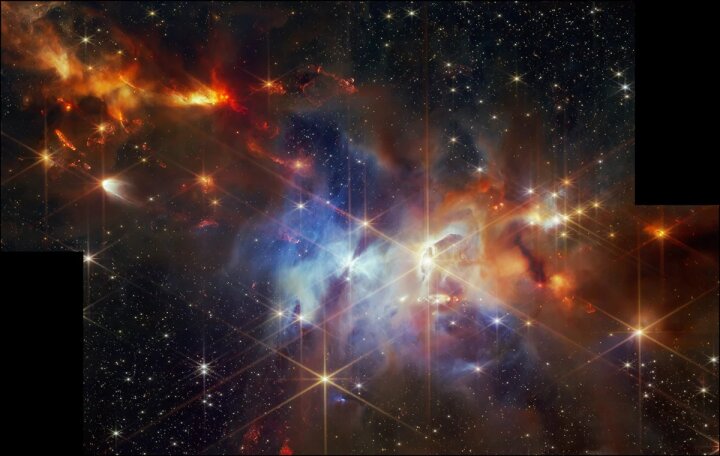What Did The JWST Actually Observe?
The James Webb Space Telescope continues to make the news as new findings surprise, and even confound, the secular astronomers interpreting the data (remember, facts don’t exist by themselves. All facts are interpreted based on one’s presuppositions). But what do we make of recent headlines such as, “Stunning JWST image proves we were right about how young stars form”? (Actually, this is nothing new . . . it’s just the latest chapter in the same rehashed star-formation story from evolutionists!)
Well, this is where understanding the difference between observational and historical science is so crucial. Just reading the headline gives the impression that the evolutionary view of star formation has been confirmed or “proven,” but let’s dig into the details.
This telescope observed 12 stars with jets of material all pointing in “roughly the same direction.” This implies that the stars are spinning in the same direction. That’s the observational science, and the article details, it’s a “phenomenon that has long been assumed, but never observed before.”
Now the astronomers interpreting the data will apply their evolutionary worldview—that’s historical science. Historical science is not directly testable, observable, or repeatable because it deals with questions about what happened in the past to produce the evidence we observe in the present. Since we weren’t there in the past to directly test or observe it and since we can’t repeat the past, historical science relies on interpreting the evidence in the present through a specific worldview lens.
So the evolutionary interpretation of these jets of material is this: As a colossal cloud of gas begins to collapse in on itself to form a star, its rotation increases. . . . This spinning causes a disc of dust and gas to form around the young star at the centre of the cloud, feeding material into the cloud itself. The powerful magnetic fields in the disc then create jets of material that blast away from the star along its spin axis, so we can use these jets to measure the direction of a young star’s spin.
This interpretation assumes the big bang and evolutionary ideas based on naturalism, regarding the formation of stars. Our astronomer, Dr. Danny Faulkner, explains the evolutionary perspective this way: Astronomers who are committed to naturalistic origins must hypothesize the birth of stars in the universe today. That is because the lifetimes of many stars are less than the supposed 13.8-billion-year age of a big bang universe, and so these stars cannot date from the beginning of the universe. Where do secular astronomers think stars can form? There are many clouds of gas within the galaxy that have a composition that matches that of stars well, so most astronomers think that the gravity of these clouds causes the clouds to collapse, fragmenting into many protostars. If the stars come from the same cloud of gas, then the stars ought to share common characteristics, such as composition. Another similarity that stars forming from a cloud ought to share is a common spin orientation (yes, stars, including the sun, spin). This similar orientation has long been a theory, but a new study provides what many astronomers think is the first evidence of the same orientation of forming stars. The theory of star formation suggests that forming stars have jets of material emanating in opposite directions along their poles of rotation. A new JWST image of a region of the constellation Serpens thought to be the location of star formation shows the alignment of several jets from stars thought to be forming. If confirmed, this could be evidence of the recent, common origin of these stars. However, keep in mind that evidence could be interpreted in other ways too.
So, with all that in mind, consider this: did the scientists actually witness this supposed formation process? No! You need to realize that no one (other than God) saw these stars form. In fact, contrary to the “clickbait” headlines we usually see in the news, scientists have never seen a star form in space. Again, it’s the interpretation of the data based on their worldview, believing that stars are forming in gas and dust clouds and believing these clouds surrounding the star had a role in the star’s formation. Also note that these images are static, meaning they don’t show any change over time. Rather, the images are being interpreted in terms of their naturalistic beliefs about star formation.
But could there be another explanation for why these 12 stars appear to be spinning in the same direction? Well, when we apply the biblical worldview, we understand that stars didn’t evolve or form gradually from collapsing gas clouds over millions of years. They were created by God when he spoke on day four of creation week. So, yes, God could’ve created these stars all spinning in the same direction, or perhaps, there’s more to understand about these stars as astronomers continue digging into the data the JWST is returning to us.
Nonetheless, stars that are aligned in terms of their rotation are not a problem for an all-powerful God. Also, it’s important to note that just because dense gas is observed around a star, this does not automatically mean that the gas has anything to do with the formation of the star. From a biblical-creation perspective, it’s possible that God simply created the clouds of gas and dust at the same time the stars were created, thousands of years ago.
When we see claims in the news about evolutionary ideas being confirmed (or so-called “proved”), it’s important that we separate the actual data from the interpretation—in other words, the observational science from the historical science.
Here’s what our rocket scientist, Rob Webb, shared with me about the big “takeaway” from this study: Overall, as a Christian, the main takeaway from these spectacular images of the heavens should be to praise the almighty Creator that we serve. If you think about it, it’s actually quite sad that unbelievers when studying the heavens completely miss all that beauty! As an analogy, it’s like someone analyzing the reasons for specific colors of a painting, like trying to figure out why green is green, why blue is blue, and so on—rather than taking a step back and simply admiring the beauty of the painting and giving honor to the painter who painted it. So when I look at images of the Serpens Nebula that show jets of material blasting away from stars, I see order, design, and beauty—and ultimately the glory of our powerful God and his handiwork. Psalm 19:1 says, “The heavens declare the glory of God, and the sky above proclaims his handiwork.”
on July 1, 2024
Featured in Ken Ham Blog
Well, this is where understanding the difference between observational and historical science is so crucial. Just reading the headline gives the impression that the evolutionary view of star formation has been confirmed or “proven,” but let’s dig into the details.
This telescope observed 12 stars with jets of material all pointing in “roughly the same direction.” This implies that the stars are spinning in the same direction. That’s the observational science, and the article details, it’s a “phenomenon that has long been assumed, but never observed before.”
Now the astronomers interpreting the data will apply their evolutionary worldview—that’s historical science. Historical science is not directly testable, observable, or repeatable because it deals with questions about what happened in the past to produce the evidence we observe in the present. Since we weren’t there in the past to directly test or observe it and since we can’t repeat the past, historical science relies on interpreting the evidence in the present through a specific worldview lens.
So the evolutionary interpretation of these jets of material is this: As a colossal cloud of gas begins to collapse in on itself to form a star, its rotation increases. . . . This spinning causes a disc of dust and gas to form around the young star at the centre of the cloud, feeding material into the cloud itself. The powerful magnetic fields in the disc then create jets of material that blast away from the star along its spin axis, so we can use these jets to measure the direction of a young star’s spin.
This interpretation assumes the big bang and evolutionary ideas based on naturalism, regarding the formation of stars. Our astronomer, Dr. Danny Faulkner, explains the evolutionary perspective this way: Astronomers who are committed to naturalistic origins must hypothesize the birth of stars in the universe today. That is because the lifetimes of many stars are less than the supposed 13.8-billion-year age of a big bang universe, and so these stars cannot date from the beginning of the universe. Where do secular astronomers think stars can form? There are many clouds of gas within the galaxy that have a composition that matches that of stars well, so most astronomers think that the gravity of these clouds causes the clouds to collapse, fragmenting into many protostars. If the stars come from the same cloud of gas, then the stars ought to share common characteristics, such as composition. Another similarity that stars forming from a cloud ought to share is a common spin orientation (yes, stars, including the sun, spin). This similar orientation has long been a theory, but a new study provides what many astronomers think is the first evidence of the same orientation of forming stars. The theory of star formation suggests that forming stars have jets of material emanating in opposite directions along their poles of rotation. A new JWST image of a region of the constellation Serpens thought to be the location of star formation shows the alignment of several jets from stars thought to be forming. If confirmed, this could be evidence of the recent, common origin of these stars. However, keep in mind that evidence could be interpreted in other ways too.
So, with all that in mind, consider this: did the scientists actually witness this supposed formation process? No! You need to realize that no one (other than God) saw these stars form. In fact, contrary to the “clickbait” headlines we usually see in the news, scientists have never seen a star form in space. Again, it’s the interpretation of the data based on their worldview, believing that stars are forming in gas and dust clouds and believing these clouds surrounding the star had a role in the star’s formation. Also note that these images are static, meaning they don’t show any change over time. Rather, the images are being interpreted in terms of their naturalistic beliefs about star formation.
But could there be another explanation for why these 12 stars appear to be spinning in the same direction? Well, when we apply the biblical worldview, we understand that stars didn’t evolve or form gradually from collapsing gas clouds over millions of years. They were created by God when he spoke on day four of creation week. So, yes, God could’ve created these stars all spinning in the same direction, or perhaps, there’s more to understand about these stars as astronomers continue digging into the data the JWST is returning to us.
Nonetheless, stars that are aligned in terms of their rotation are not a problem for an all-powerful God. Also, it’s important to note that just because dense gas is observed around a star, this does not automatically mean that the gas has anything to do with the formation of the star. From a biblical-creation perspective, it’s possible that God simply created the clouds of gas and dust at the same time the stars were created, thousands of years ago.
When we see claims in the news about evolutionary ideas being confirmed (or so-called “proved”), it’s important that we separate the actual data from the interpretation—in other words, the observational science from the historical science.
Here’s what our rocket scientist, Rob Webb, shared with me about the big “takeaway” from this study: Overall, as a Christian, the main takeaway from these spectacular images of the heavens should be to praise the almighty Creator that we serve. If you think about it, it’s actually quite sad that unbelievers when studying the heavens completely miss all that beauty! As an analogy, it’s like someone analyzing the reasons for specific colors of a painting, like trying to figure out why green is green, why blue is blue, and so on—rather than taking a step back and simply admiring the beauty of the painting and giving honor to the painter who painted it. So when I look at images of the Serpens Nebula that show jets of material blasting away from stars, I see order, design, and beauty—and ultimately the glory of our powerful God and his handiwork. Psalm 19:1 says, “The heavens declare the glory of God, and the sky above proclaims his handiwork.”
on July 1, 2024
Featured in Ken Ham Blog
















